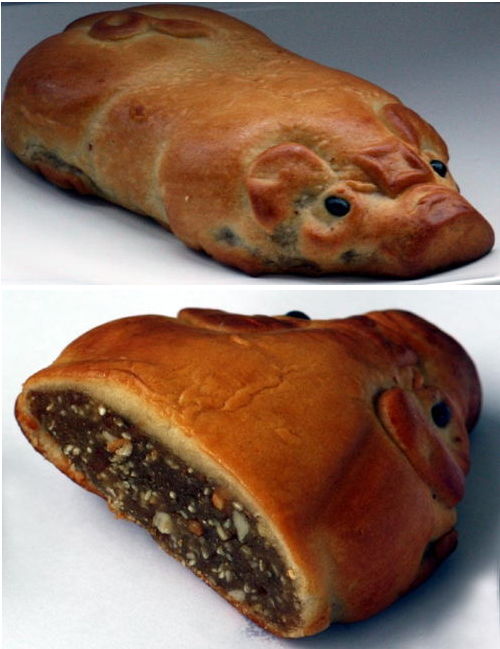Food
Follies of the Mad Men #185
The way to a dwarf's heart is through his stomach.
Posted By: Paul - Wed Jun 27, 2012 -
Comments (5)
Category: Business, Advertising, Products, Food, Myths and Fairytales, 1970s
Happy To See Food
These people sure are happy at the sight of food. Or are they happy because of the amazingly low prices? 49 cents for a 12-pack of Dr. Pepper! That's less than a nickel per can. (These are 1950's prices.)

Posted By: Alex - Sat Jun 16, 2012 -
Comments (6)
Category: Food, Advertising
Chocolate Toilet

This chocolate toilet was created by artist Art Domantay and displayed at The Project (Fall 2002 - Winter 2003). He titled it, "Sweet Ass."
But his toilet appears to be missing a toilet seat cover. Never fear. Creative Chocolates of Vermont offers a white-chocolate toilet seat cover for $15.

Note that the chocolate toilet is considered art, whereas the white-chocolate toilet seat cover is just a novelty item.
Posted By: Alex - Sun Jun 03, 2012 -
Comments (7)
Category: Bathrooms, Food, Chocolate
Psychic Land
Posted By: Paul - Sun May 27, 2012 -
Comments (2)
Category: Aliens, Food, Surrealism, Cartoons
Snail Porridge
According to Heston Blumenthal, "snail and porridge might sound like a bit of a bizarre combination, but it's totally delicious to eat." I'll take his word for it, but this is one dish I'm not going to try. To make the dish, it sounds like you mix snails and porridge together. Then you add in a whole bunch of other stuff to hide the taste of the snails.
Posted By: Alex - Sun May 13, 2012 -
Comments (5)
Category: Food
Jughead Licks An Old Man Wearing Ice Cream

[Click to enlarge]
Forever will the image of Jughead licking icecream off the head of Pop Tate haunt your every waking moment.
But if that's not enough old-school Archie weirdness for you, please click the link and purchase the newest volume of the Archie Archives.
Posted By: Paul - Fri May 11, 2012 -
Comments (2)
Category: Food, Comics, 1940s, Eating, Goofs and Screw-ups
The Benefits of Placentophagy
In a recent article in the journal Ecology of Food and Nutrition, Mark Kristal argues that placentophagia (that is, the eating of afterbirth or placenta) could offer significant benefits for humans — especially considering that all other mammals (including non-human primates) do it. (link: ScienceDaily.com). These benefits might include increasing mother-infant interaction, increasing the effects of pregnancy-mediated analgesia in the delivering mother, and potentiating opioid circuits in the maternal brain that facilitate the onset of caretaking behavior. He acknowledges that these possible benefits don't warrant "the wholesale ingestion of afterbirth," but he does think the issue deserves further study.The strange thing is that although all other mammals practice placentophagy, no human cultures do (according to Dr. Kristal) — except for Hollywood celebrities.
Posted By: Alex - Mon Apr 09, 2012 -
Comments (6)
Category: Babies, Food, Nutrition, Health
Golden Pig Cakes
A Chinese delicacy. Looks like a pig, and yet it's vegetarian. According to the Liuzhou Laowai blog: "The dense cake is made from lotus seed paste flavoured with nuts and sesame seeds, wrapped in a heavy sweet pastry. They are also used symbolically to ensure that the dead have enough to eat in heaven."
Posted By: Alex - Fri Apr 06, 2012 -
Comments (5)
Category: Food
Norwegian Egg Coffee
After watching this video, I'm curious to try some Norwegian Egg Coffee. The person in the video left this explanation on youtube in response to all the comments:
Posted By: Alex - Mon Mar 26, 2012 -
Comments (13)
Category: Food, Coffee and other Legal Stimulants, Eggs
Fresh Guacamole
Longtime WU-vies will surely recall PES's video of humping furniture.
Posted By: Paul - Fri Mar 09, 2012 -
Comments (3)
Category: Food, Surrealism, Stop-motion Animation

| Who We Are |
|---|
| Alex Boese Alex is the creator and curator of the Museum of Hoaxes. He's also the author of various weird, non-fiction, science-themed books such as Elephants on Acid and Psychedelic Apes. Paul Di Filippo Paul has been paid to put weird ideas into fictional form for over thirty years, in his career as a noted science fiction writer. He has recently begun blogging on many curious topics with three fellow writers at The Inferior 4+1. Contact Us |




